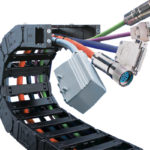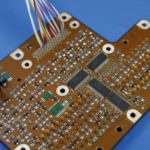By Jack Midgley, Global Defense Market Leader, Fischer Connectors www.fischerconnectors.com
Soldier modernization programs take on new urgency as funding priorities shift and operational demands increase. There are many challenges posed by resource constraints and changing operational environments. Defense connectivity solutions offer new capabilities and innovative, economical approaches to help soldiers and commanders at every level make better decisions faster — when observing, orienting, deciding and acting (OODA) in unforgiving operational environments.

There is no doubt that military forces worldwide are adapting their equipment and operating models to new levels of operational intensity. As the US Army Vision describes, forces are refocusing on “high-intensity conflict […] in dense urban terrain, in electronically degraded environments and under constant surveillance.” (1)
Advanced digital technologies
Today’s modernization efforts are increasingly focused on optimizing the ability of individual soldiers and small units to share and process information using advanced digital technology. The digital “revolution in military affairs” is happening as four key technologies have matured: artificial intelligence, augmented reality, miniaturized inexpensive sensors and efficient wearable power supplies.
These four critical technologies create unprecedented demands for connections capable of handling massive amounts of data with minimal power and weight. The four revolutionary technologies are evident in the US Army’s Integrated Visual Augmentation System (IVAS), recently approved for production. IVAS needs all four technologies to deliver its full capability, and the rush is on for effective, modular solutions to complement the massive latent capability of this new system.
In the US, Army acquisition authorities are searching for soldier modernization solutions including “body-worn systems, hand-held devices, smart lightweight electronic components and information processing to increase soldier maneuverability and protection through on-soldier sensing, remote sensing and knowledge management.” (2)
But what advantages will these revolutionary technologies bring on the battlefield? Unlike a new warhead with easily measurable qualities like accuracy or penetration, soldier-worn systems require a different yardstick. These systems connect soldiers with many types of information, and their advantage is measured in the quality and speed of decisions — those made by individual soldiers, and by commanders at every level. To take full advantage of revolutionary technologies, soldier-worn technology must collect and distribute information — that is, this technology must gain and maintain “connectivity” at each stage of the decision-making cycle.
| Accelerating tactical decision-making cycles… | …presents new challenges…. | …with new solutions. |
| OBSERVE | Integrate multi-source sensors for real-time data capture | Easy connections for multiple soldier-worn devices
|
| ORIENT | Present data in soldier-usable formats for fast analysis | Tactical hubs and connected vests integrate data and power between EUD and other body-worn devices |
| DECIDE | Connect soldiers, units and leaders reliably across the chain of command | Data and power connectors and cable assemblies deliver reliable connections in harsh environments |
| ACT | Move and communicate with confidence | 360° connectivity and direct routing of cables minimize snag hazards, reduce weight and enhance mobility |
Our new connected world
It is key to meet these new requirements with solutions that enhance connectivity at every phase in the OODA decision-making cycle. Soldier-worn technology has to contribute to rapid information processing, and a critical component to that is providing technology solutions to move information swiftly, reliably and with minimal power and size.
Observing – Orienting – Deciding – Acting (OODA)
 Observing: Soldiers operating in dense urban environments need more than their own eyes to observe and detect threats. Observations from unmanned aerial vehicles (UAVs), sensors, advanced optics, even satellite imagery and video are now available at the lowest levels of the chain of command. How can these sources be sorted, integrated, and processed to understand the environment, without overwhelming the observer? Too many devices, connected in a web of cables, make tactical observations more difficult for soldiers in fast-changing situations. It is helpful to contribute to efficient tactical observation through a large variety of ultra-rugged, compact and easy-to-use connectivity solutions. The newest in connectors and cable assemblies offer the latest technology, with enhanced interaction design, integration capability, and plug-and-go functionality. Such technology allows soldiers to connect and route observation devices in any direction, ensuring that external cables always run straight to the device. Straight connections allow soldiers to manage more devices with lightweight, uncomplicated connectors. Straight connections mean shorter cables, fewer tangles and better usability because equipment is lighter and faster to set up.
Observing: Soldiers operating in dense urban environments need more than their own eyes to observe and detect threats. Observations from unmanned aerial vehicles (UAVs), sensors, advanced optics, even satellite imagery and video are now available at the lowest levels of the chain of command. How can these sources be sorted, integrated, and processed to understand the environment, without overwhelming the observer? Too many devices, connected in a web of cables, make tactical observations more difficult for soldiers in fast-changing situations. It is helpful to contribute to efficient tactical observation through a large variety of ultra-rugged, compact and easy-to-use connectivity solutions. The newest in connectors and cable assemblies offer the latest technology, with enhanced interaction design, integration capability, and plug-and-go functionality. Such technology allows soldiers to connect and route observation devices in any direction, ensuring that external cables always run straight to the device. Straight connections allow soldiers to manage more devices with lightweight, uncomplicated connectors. Straight connections mean shorter cables, fewer tangles and better usability because equipment is lighter and faster to set up.
Orienting: Which observations require immediate attention? Which must be reported, and which can be ignored? Unless the soldier can orient rapidly and accurately, observation data — and expensive sensor equipment — can be wasted. Sophisticated connectors help soldiers orient efficiently on tactical threats by providing reliable power and data connections to the new tactical hub. Using military standard connectors solutions and a lightweight, body-worn hub, a soldier can move data efficiently from multiple sensors and communication devices onto the End-User Device (EUD) for processing and evaluation. Many advanced connectors and cable assemblies deliver rock-solid power and data connections with IP68-level sealing, while eliminating key codes and delivering 360º mating freedom. Cable-free solutions can also be achieved by integrating the panel plug directly into the housing of wearable devices such as radios, bodycams, LEDs, and alert systems or biometric sensors.
These wearables can be mated quickly and easily to ready-to-use cabled receptacles or receptacles with the new a quick detach system fitted into the fabric of a smart tactical vest. Keeping multiple devices in view and reliably connected through the hub allows soldiers to focus on the data – instead of on the devices and connections. Better focus can lead to faster, more accurate orientation to threats, maximizing the impact of soldier-worn sensors and communication devices.

Deciding: When the soldier and unit are correctly oriented, options have to be defined and a course of action selected. This takes fast, accurate communication within the unit, and between the unit and its headquarters, adjacent units and supporting elements. Defense-centric connectors add reliability and speed to military decision-making processes by keeping soldiers reliably connected to their communications and sensor suites. Shorter cables, a compact, efficient hub and tight power and data connections minimize “out of communication” challenges that slow decision making and add risk in tactical environments.
Acting: When a decision is made, soldiers need to be able to move, act and communicate rapidly and accurately. Connected vests minimize external snagging hazards and allow instant connection or disconnection of wearable devices. By using a single battery to power all the soldier’s body-worn technology, the solution lightens the soldier’s load, increasing agility and speed of movement. No soldier should have to think about connected devices when the time comes for decisive action, and a connector system — improved connectors, tactical hub, low-profile cables and optimized power management — is the ideal approach for helping soldiers act with maximum effect. The next generation of soldier-worn equipment will allow individual soldiers to apply information and insight, once available, only to higher commanders and staff.
In summary
Military OEM design engineers of wearable devices and tactical vests can simplify their designs and connectivity solutions with quality connectors and cable assemblies, which can optimize soldier productivity at every step of the decision cycle – observing, orienting, deciding and acting. Plug-and-go connectors that have 360º mating capabilities have been specially engineered to optimize cable and power management. The panel plug can be directly integrated into the housing of wearables such as sensors, bodycams, LEDs, IR beacons, flash drives, etc. Such wearables can quickly be mated to a ready-to-use cabled receptacle with a quick detach system fitted into the fabric of a connected vest.
Fischer Connectors
fischerconnectors.com
1 “The Army Strategy” www.army.mil/e2/downloads/rv7/the_army_strategy_2018.pdf
2 US Army Devcom Broad Agency Announcement, March 2020. www.dsjournal.com/2020/03/26/us-army-combat-capabilitiesdevelopment-commands-soldier-center-issues-broad-agency-announcement-baa-for-basic-and-applied-research/






